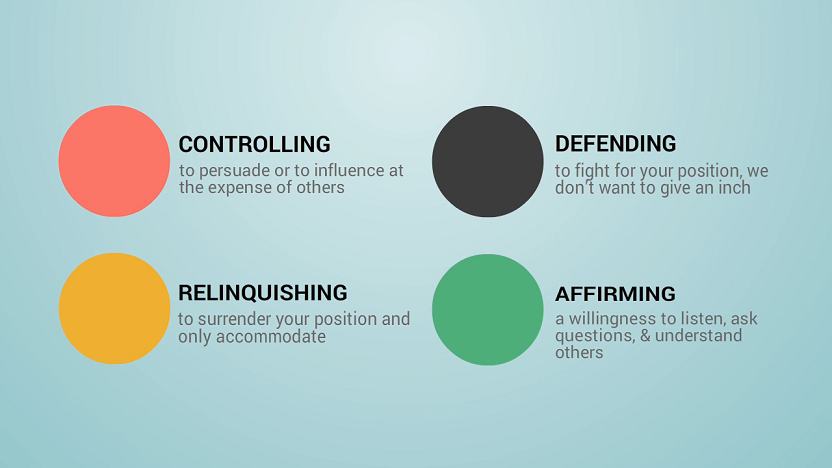
Four Strategies for Preventing Toxic Team Conflict
In this blog, we’re going to discuss four strategies for preempting and reducing toxic conflict and building positive team interactions.
Introduction
No matter how smart, stellar, or successful your team may be, conflicts are unavoidable. Some of these are natural conflicts – disagreements on perspective and viewpoint. Others can fester and become infected with resentment and jealousy. Every team is made better by the give-and-take between its members. It’s the lingering, toxic conflict that you want to preempt and avoid.
The first strategy is to recognize that we all have natural differences in the way we think and communicate.
We use the term “communication style” to describe this complex mélange of how we process information and respond. Some people focus first on the task to be done; others are more focused on feelings. Some individuals are highly assertive; others are less so. The Straight Talk® book helps people understand and appreciate the nuances of these different styles.
In a team environment…
Directors’ tendency to make abrupt decisions may not be well received by those, specifically Expresser or Harmonizer team members, who wish to discuss a point or issue in detail.
Expressers may have too many ideas and be too loquacious, lack clear priorities, and have difficulty following through. It can be hard for them to relate to people who are quiet and analytical i.e. with Thinkers.
Thinkers can tend to be linear in their thinking, sometimes unwilling to take risks, may miss deadlines and may be blind to the big picture. This can be challenging in a team when there are Director-style personalities.
Harmonizers often avoid conflict and are resistant to change, make decisions slowly, and may not be clear about their goals. They are most likely to experience conflicts with Directors.
No one’s communication style is right or wrong, good or bad. The key to avoiding toxic conflict is to raise the level of understanding and appreciation about the different styles of your team. You can’t let differences in style become a barrier. Instead, you need to model and encourage patience, understanding, listening, and appreciation. This is the first step in laying a solid foundation for avoiding toxic conflict.
Tip: Create a team profile at GoStraightTalk.com by inviting your co-workers to take the Straight Talk survey. Each member will be able to compare styles and receive specific tips to improve their communication.
For leaders and managers, it’s helpful to have positive ways to frame each style.
Here are the positive assumptions that accompany each style:
Director Teams
- Action is better than inaction.
- We should act more quickly.
- We should reward bold decisions.
Expresser Teams
- Every idea is worth considering.
- People should be willing to try anything once.
- We should reward creativity.
Thinker Teams
- Analysis can solve any problem.
- There’s a right–and wrong– way to do things.
- We should reward people who do things right.
Harmonizer Teams
- Good relationships are essential to our success.
- People shouldn’t argue, but seek to understand.
- We should reward people who work well together.
As a leader of a team, you should try to help move the team toward a balanced style of communicating. For example, if a team is paralyzed by indecision, then injecting more people with the Expresser or Director style will get them moving. If a group is acting too quickly, then a Thinker or Harmonizer style should be added to the mix.
Learn more about Straight Talk Leadership Styles.
Exercise:
Make note of the potential strengths and shortcomings of your team, based on your understanding of its members’ styles. Then note 1-3 strategies to mitigate the weaknesses.
- Potential strengths of the team
- Potential weaknesses of the team
- 1-3 strategies to mitigate the potential weaknesses of the team
The second strategy is to focus people on appreciating their intentions when they communicate – and avoiding the type of intention that can lead to toxicity.
There are four types of intentions that one can experience. Only one of these four types is positive.
This is the affirming intention. You display it by affirming the value of what other people say and, at the same time, clearly communicating your own point of view. Affirming is done using inquiry, saying things like, “Help me understand?” or “What led you to that conclusion?”
The second type of intention is called defending. You’ll hear phrases such as “That’s not what I meant.” “You didn’t hear me correctly.” “That’s not what I said.” As soon as defensiveness creeps in, people are on emotional alert, and they become guarded and feel unsafe – a poor environment in which to build a team; one that can lead to unproductive behavior.
The third type of intention is controlling. You’ll recognize it when people are nit-picky and micromanaging. “Why did you do this?” “Why did you do that?” “Next time, you should do this…” If abused, a controlling intention will lead to resentment and team dysfunction.
The fourth type of intention is relinquishing. It is a whatever-you-want-to-do-is-fine-with-me approach. It signals that the person has stopped caring and is no longer a full participant in the team. This can quickly degenerate into toxic conflict.
Among these types of intention, the affirming intent is obviously the most effective.
People who exercise genuine inquiry, listen intently, and create a safe environment for others to express their views are always going to be the most effective team members.
The other three forms of intention can quickly lead to unnatural conflict and team dysfunction.
The third strategy is to establish ground rules for your team.
Ground rules are important because they set a clear standard for productive behavior and communication. Ground rules should include things like encouraging equal talk time, asking people to balance advocacy and inquiry, showing respect for different points of view, and avoiding groupthink. To keep the level of discussion challenging and thoughtful, I often identify a “pot stirrer” to make sure people consider several options before they move to a decision.
- Understand each other’s styles
- Agree on the meaning of keywords
- Tackle issues, not people
- Permit one speaker at a time (avoid side conversations)
- Bring issues to the table (avoid “backroom” discussions)
- Keep discussions focused
- Explain the reasoning leading to your conclusions
- Invite inquiry into your views
- Inquire into the reasoning of others
- Make “undiscussable” ideas discussable
- Identify missing data
Tip: The following ground rules (click here) have proven successful time after time. Each ground rule points to one of the tools or skills embodied in straight talk.
The fourth strategy is to understand and be clear about decision making roles on the team and outside the team.
Will your team operate on the basis of consensus? Will you take votes and operate democratically? Will you operate consultatively, where the team’s input feeds into a decision made by one person? Making sure in advance that everyone is on the same page in terms of how issues will be decided can preempt a lot of toxic conflicts. The important thing is to be clear about it and then to follow through – people don’t like having one set of rules in place, only to suddenly find the rules have been changed. If, for instance, you’ve established that decisions need to be reached by consensus, your team must work through the decision until you reach an agreement. You can’t suddenly decide that one person will make the decision.
Tip: Check out our advanced video course, “The Art of Managing Decisions” for an organizational license to get everyone using the same vocabulary of decision-making and design for decision-making processes.
At the root of all toxic conflict is a lack of trust.
The strategies described here are all designed to build understanding and trust. If you use them, you’ll be a much more effective team member and team leader.
Tip: Check out The Leadership Equation book learn about the 10 practices that build trust and spark innovation.


+ There are no comments
Add yours